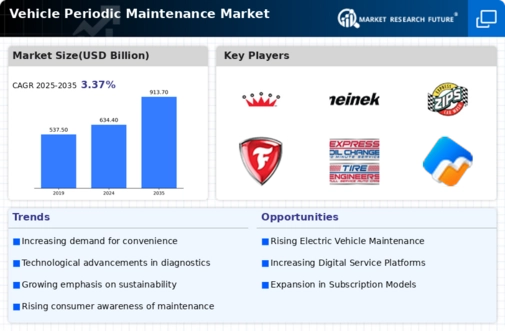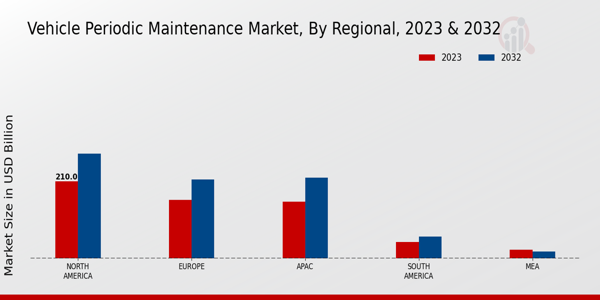Market Growth Projections
The Global Vehicle Periodic Maintenance Market Industry is poised for substantial growth, with projections indicating a market value of 634.4 USD Billion in 2024 and an anticipated increase to 913.7 USD Billion by 2035. This growth trajectory suggests a compound annual growth rate of 3.37% from 2025 to 2035. Factors contributing to this expansion include rising vehicle ownership, technological advancements, and increased regulatory compliance. As the market evolves, stakeholders are likely to adapt to changing consumer preferences and technological innovations, ensuring sustained growth in the vehicle maintenance sector.
Increasing Vehicle Ownership
The Global Vehicle Periodic Maintenance Market Industry is experiencing growth driven by the rising number of vehicles on the road. As urbanization continues to expand, more individuals are acquiring personal vehicles, leading to an increased demand for maintenance services. In 2024, the market is valued at approximately 634.4 USD Billion, reflecting the necessity for regular upkeep to ensure vehicle longevity and safety. This trend is particularly pronounced in developing regions where vehicle ownership rates are surging. Consequently, the need for periodic maintenance services is likely to rise, contributing to the overall market expansion.
Expansion of Service Networks
The expansion of service networks is a crucial factor influencing the Global Vehicle Periodic Maintenance Market Industry. As automotive service providers broaden their reach, they enhance accessibility for consumers seeking maintenance services. This expansion includes the establishment of service centers in urban and rural areas, catering to a diverse customer base. Additionally, partnerships between manufacturers and service providers are becoming more common, facilitating comprehensive maintenance solutions. This trend is expected to support the market's growth trajectory, with projections indicating a market value of 913.7 USD Billion by 2035, underscoring the increasing demand for accessible maintenance services.
Regulatory Compliance and Safety Standards
The Global Vehicle Periodic Maintenance Market Industry is significantly influenced by stringent regulatory frameworks aimed at ensuring vehicle safety and environmental compliance. Governments worldwide are implementing regulations that mandate regular inspections and maintenance to reduce emissions and enhance road safety. For example, many countries require periodic emissions testing, which necessitates regular vehicle maintenance. As these regulations become more rigorous, vehicle owners are compelled to invest in maintenance services, thereby propelling market growth. This trend is expected to continue as governments prioritize sustainability and safety in transportation.
Rising Awareness of Preventive Maintenance
There is a growing awareness among vehicle owners regarding the importance of preventive maintenance, which is a key driver for the Global Vehicle Periodic Maintenance Market Industry. Educated consumers are increasingly recognizing that regular maintenance can prevent costly repairs and extend vehicle lifespan. This shift in mindset is leading to higher demand for scheduled maintenance services, such as oil changes and tire rotations. As the market evolves, it is projected that the emphasis on preventive care will contribute to a compound annual growth rate of 3.37% from 2025 to 2035, reflecting a proactive approach to vehicle upkeep.
Technological Advancements in Maintenance Services
Technological innovations are reshaping the Global Vehicle Periodic Maintenance Market Industry. The integration of advanced diagnostic tools and software enhances the efficiency and accuracy of maintenance services. For instance, the adoption of telematics allows for real-time monitoring of vehicle performance, enabling proactive maintenance. This trend not only improves service quality but also reduces costs associated with unexpected breakdowns. As technology continues to evolve, it is anticipated that the market will see a shift towards more automated and data-driven maintenance solutions, further driving growth in the coming years.











